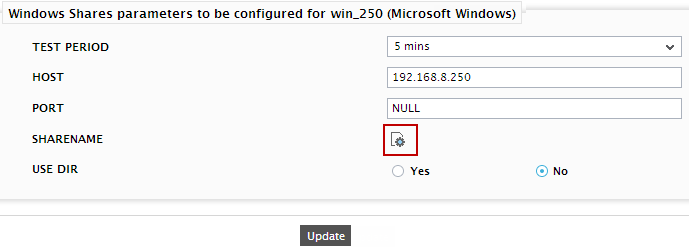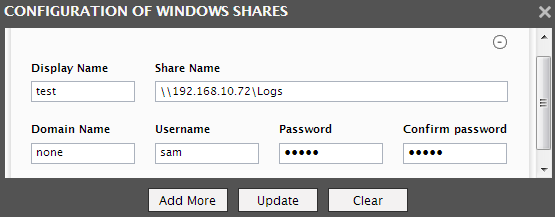Windows Shares Test
This test periodically connects to remote Windows hosts in the target environment, verifies whether shared folders configured for monitoring exist on those hosts, and also reports whether/not configured users have at least 'read-only' access to those folders.
This test is disabled by default. To enable the test, go to the enable / disable tests page using the menu sequence : Agents -> Tests -> Enable/Disable, pick the desired Component type, set Performance as the Test type, choose the test from the DISABLED TESTS list, and click on the << button to move the test to the ENABLED TESTS list. Finally, click the Update button.
Target of the test : A Windows host
Agent deploying the test : An internal agent
Outputs of the test : One set of results for every sharename configured
| Parameter | Description |
|---|---|
|
Test Period |
How often should the test be executed. |
|
Host |
The host for which the test is to be configured. |
|
Port |
The port at which the specified host listens. By default, this is NULL. |
|
Share name |
To view/configure the shared folders for monitoring, the eG administrative interface embeds a special configuration page. To access this page, click on the |
|
USE DIR |
By default, this test uses the net share command to report metrics. In some environments, the net share command may falsely alert you to the unavailability of a shared folder - i.e., it may report that a shared folder is unavailable, when in fact, it is available. In such environments therefore, you may want to use the dir command instead to report metrics. To use the dir command, set this flag to Yes. By default, this flag is set to No. |
| Measurement | Description | Measurement Unit | Interpretation |
|---|---|---|---|
|
Is authentication of share folder successful? |
Indicates whether this shared folder exists or not. |
|
The value 100 for this measure indicates that the share exists. If the measure reports the value 0, it indicates that the shared folder does not exist. If so, then the test attempts to create the share using the configured user credentials. |
|
Is share folder accessible? |
Indicates whether/not the configured user has at least ‘read-only’ access to this shared folder. |
|
If the shared folder exists (i.e., if the Share Authentication measure reports the value 100), then the value 100 for this measure indicates that the configured user can open the shared folder and read its contents. If the shared folder does not exist (i.e., if the Share Authentication measure reports the value 0), then the value 100 for this measure indicates that the configured user could create the shared folder. Likewise, if the shared folder exists (i.e., if the Share Authentication measure reports the value 100), then the value 0 for this measure indicates that the configured user does not have the right to access the folder. On the other hand, if the shared folder does not exist (i.e., if the Share Authentication measure reports the value 0), then the value 0 for this measure indicates that the configured user could not create the shared folder. |
Configuring the Windows Shares
To configure the Windows share folders, do the following;
-
Click on the
 icon in the test configuration page as show in Figure 1.
icon in the test configuration page as show in Figure 1.
-
Then, the Configuration of Window Shares pop up window appears as shown in Figure 2.

-
Next, specify the following in Figure 2;
-
Display name : Provide the display name of the shared folder to be monitored in the Display Name text box. This Display Name will appear as the descriptor of the test.
-
Share Name : Specify the exact path to the shared folder in the Share Name text box. For instance, the Share Name can be: \\192.168.10.72\Logs.
-
Domain Name : In this text box, specify the name of the domain to which the user specified in the Username text box belongs to. If the user does not belong to any domain, then specify none in the Domain name text box.
-
Username and Password : Specify the credentials of the user who is authorized to access the configured shared folder, in the Username and Password text boxes.
-
Confirm Password : Confirm the password by retyping it in the Confirm Password text box.
-
Finally , click on the Update button to configure the shared folder. This will lead you back to the test configuration page. To configure more shared folders, click on the Add more button and specify the details as explained above. Use the Clear button to clear all the shared folder configurations. To remove the any one of the share folder specification, use the encircled minus button in the top right-corner.
